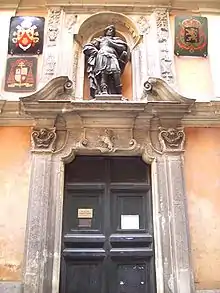National churches in Rome
Charitable institutions attached to churches in Rome were founded right through the medieval period and included hospitals, hostels, and others providing assistance to pilgrims to Rome from a certain "nation", which thus became these nations' national churches in Rome (Italian: chiese nazionali). These institutions were generally organized as confraternities and funded through charity and legacies from rich benefactors belonging to that "nation". Often, they were also connected to national scholæ (ancestors of Rome's seminaries), where the clergymen of that nation were trained. The churches and their riches were a sign of the importance of their nation and of the prelates that supported them. Up to 1870 and Italian unification, these national churches also included churches of the Italian states (now called "regional churches").

Many of these organizations, lacking a purpose by the 19th century, were expropriated through the 1873 legislation on the suppression of religious corporations. In the following decades, nevertheless, various accords – ending up in the Lateran Pacts – saw the national churches' assets returned to the Catholic Church.
Italian regional churches
- Abruzzo: Santa Maria Maddalena in Campo Marzio
- Apulia: Basilica di San Nicola in Carcere
- Basilicata: San Nicola in Carcere
- Calabria: San Francesco di Paola ai Monti
- Campania: Santo Spirito dei Napoletani
- Dalmatia: San Marco Evangelista in Agro Laurentino
- Emilia-Romagna: Santi Giovanni Evangelista e Petronio dei Bolognesi
- Istria: San Marco Evangelista in Agro Laurentino
- Lazio:
- Marche: San Salvatore in Lauro
- Piedmont: Santissimo Sudario all'Argentina
- Sardinia: Santissimo Sudario all'Argentina
- Sicily: Santa Maria Odigitria al Tritone
- Tuscany:
National churches
Africa
Americas
- Argentina: Santa Maria Addolorata a Piazza Buenos Aires
- Canada: Nostra Signora del Santissimo Sacramento e Santi Martiri Canadesi
- Chile: Santa Maria della Pace
- Ecuador: Santa Maria in Via[1]
- Mexico: Nostra Signora di Guadalupe e San Filippo Martire
- Peru: Sant'Anastasia al Palatino
- United States of America:
Asia
Europe
- San Giovanni della Malva in Trastevere[4][5]
- Sant'Atanasio a Via del Babuino (Græco-Byzantine rite)
- San Basilio agli Orti Sallustiani (Græco-Byzantine rite)
- Santa Maria in Cosmedin (Græco-Melkite rite)
- San Teodoro al Palatino (Eastern Orthodox)
- Santo Stefano Rotondo al Celio
- Santo Stefano degli Ungheresi (demolished)
- Santo Stefano in Piscinula (demolished)
- Sant'Isidoro a Capo le Case
- San Clemente al Laterano
- San Patrizio a Villa Ludovisi (former)
- Santa Maria in Posterula (demolished)
- Lithuania:
- Lietuvių koplyčia (within San Pietro in Vaticano)[10]
- San Casimiro a Via Tusculano[11]
- Malta:
- Norway: Sant'Olav (within Santi Ambrogio e Carlo al Corso)
- Poland:
- Portugal: Sant'Antonio dei Portoghesi
- Romania: San Salvatore alle Coppelle (Byzantine-Romanian rite)
- Russia: Sant'Antonio Abate all'Esquilino
- Scotland:
- Sant'Andrea degli Scozzesi (deconsecrated)
- Il Pontificio Collegio Scozzese
- Santi Sergio e Bacco
- San Giosafat al Gianicolo
- Santa Sofia a Via Boccea (Byzantine-Ukrainian rite)
Note
- Reserved to the Swiss Guards.
References
- "Comunità ecuadoriana Chiesa di Santa Maria in Via". Roma Multietnica (in Italian). 2007-07-01. Archived from the original on 2022-04-22. Retrieved 2018-08-14.
- Macchi, David (2013-11-18). "Church of Our Lady of Coromoto". Romapedia (in American English and Italian). Archived from the original on 2022-02-07. Retrieved 2022-04-22.
- Hager, June (June 1999). "A Special Christianity: The Armenian Catholic Community in Rome". Inside the Vatican. Archived from the original on 2017-06-03. Retrieved 2022-04-22 – via The Catholic Liturgical Library.
- "Chiesa S. Giovanni della Malva in Trastevere". Roma Multietnica (in Italian). 2007-08-21. Archived from the original on 2022-04-22. Retrieved 2022-04-22.
- "San Giovanni della Malva in Trastevere". Minnistero del'Interno (in Italian). Archived from the original on 2015-09-30. Retrieved 2022-04-22.
- Schmidlin, August Joseph (1913). . In Herbermann, Charles (ed.). Catholic Encyclopedia. New York: Robert Appleton Company.
- Walsh, Michael (2015-09-30). Every Pilgrim's Guide to Rome. Norwich: Canterbury Press. ISBN 978-1-8482-5618-7. OCLC 971560329. OL 25962899M. Retrieved 2022-04-22 – via Google Books.
- "Ambassade de France près le Saint-Siège" [Embassy of France to the Holy See]. La France au Vatican (in French). Archived from the original on 2022-04-14.
- "Églises françaises à Rome" [French Churches in Rome] (in French). Pieux Établissements de la France à Rome et à Lorette. Archived from the original on 2022-01-26. Retrieved 2022-04-22.
- Žemaitis, Augustinas. "Rome and Italy". Global True Lithuania (in American English and Lithuanian). Archived from the original on 2022-02-21. Retrieved 2022-04-22.
- "Pontifical Lithuanian College of St. Casimir – Guest House Villa Lituania". Villa Lituania. Archived from the original on 2022-04-22. Retrieved 2022-04-22.
- "Santi Michele e Magno". The Hidden Churches of Rome. Archived from the original on 2020-02-20. Retrieved 2022-04-22.
Bibliography
- Giuliani, Raffaella (1999). "The Martyr's Sanctuaries (The Catacombs)". In Gioia, Francesco (ed.). Pilgrims in Rome: the official Vatican guide for the Jubilee Year 2000. New York City: Continuum. p. 124. ISBN 0-8264-1187-8. LCCN 99029745. OCLC 41278452. OL 39835M. Retrieved 2022-04-22 – via Internet Archive.
- Sabatini, Carlo, ed. (1979). Le chiese nazionali a Roma [National churches in Rome] (in Italian). Rome: Istituto Poligrafico e Zecca dello Stato.
- Roma. La biblioteca di Repubblica Italia (in Italian). Vol. 2. Milan: Touring Club Italiano. 2004. OCLC 1045898482.
External links
- "Churches of the Nations and of the Guilds in Rome". Rome in the Footsteps of an XVIIIth Century Traveller. Archived from the original on 2021-11-15. Retrieved 2022-04-22.